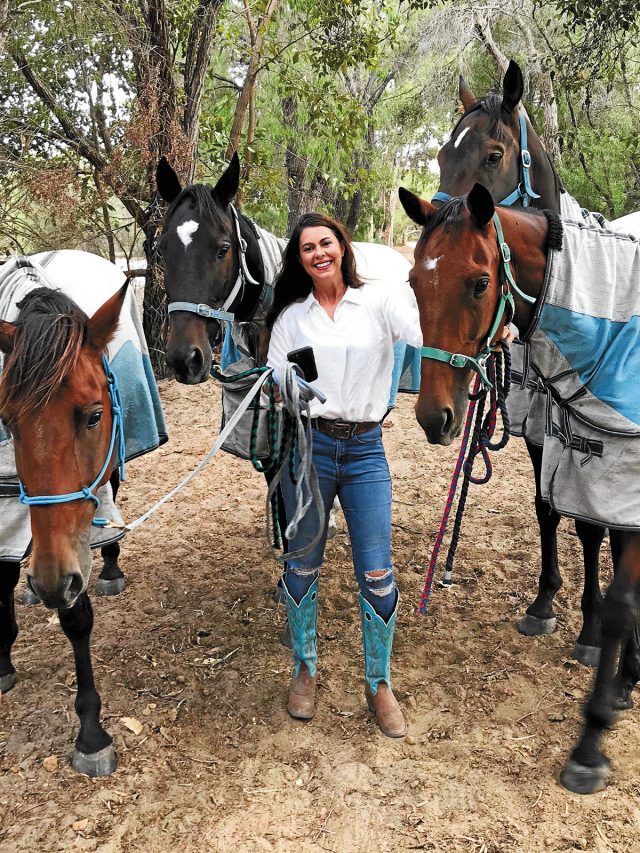Cristelle Capitani, the director of Autism Horses Australia in Gingin, is on a mission: to develop independent functioning for every child on the spectrum, one family at a time, using equine assisted therapy (EAT).
A horse lover, therapist and a mother to children on the autism spectrum, this serendipitous combination lead her to developing the program after seeing the benefits being around horses was having on her own kids.
Cristelle relocated from the Great Southern to Perth with her family in order to navigate the rocky road of autism assessment for two of her children and to make accessing therapy easier. After settling in to their therapy routine, they felt confident to move further out of the city, back onto a property and to once again have horses as part of their family.
“I noticed this wonderful effect the horses were having on the children,” says Cristelle. “I went looking for equine assisted therapy and I couldn’t find anything that would fit our needs. Then I thought, “Well hang on a minute. I’m already a therapist and I have horses – this is a gap in the market that I can fill.”
The earliest recorded mention of equine therapy is in the writings of Hippocrates, a Greek physician born in 460 BCE. He wrote about hippotherapy, derived from “hippos,” the Greek word for horse. Today it is used to help treat stress, depression, post-traumatic stress disorder and is an effective emerging practice for those with autism spectrum disorder.
“When they are in with their horses it slows their nervous system down,” explains Cristelle. “Children on the autism spectrum have no sense of what we call interoception – where you have a conscious awareness of your internal landscape. When you start to get angry or tired or hungry, you first feel that internally, and a lot of children with autism do not have that.
“With their nervous system relaxed, they are more calm, able to listen to those signals and begin to regulate their behaviour.”
Transference of these self-regulation skills to the outside world is the ultimate goal of the therapy.
“A huge fear of us parents of children with autism is, ‘What is going to happen to my child when I’m not around?’,” says Cristelle. “When they grow up, they need to be able to pay attention to those internal signals so they can make decisions and live a meaningful life.”
AHA’s sessions are less rigid and structured than traditional therapy. They are led by the child, with no prompting, which immediately removes a lot of anxiety, common among children with autism. The focus is on letting the child develop his or her relationship with the horse without influence.
“In the sessions I use applied behavioural analysis to count and observe behaviours, such as reciprocating eye contact, forward body movements – any kind of behaviour that represents the child coming out of internalising,” explains Cristelle.
The sessions also work on capacity building. Children develop gross motor skills by participating in a fancy-dress session with their horse – brushing them, undoing buckles and zips on accessories and taking them for a walk. All sessions are adjusted to suit the support plan of the child and their family.
Horses in AHA’s therapy herd are all ex-racehorses, something Cristelle was moved to incorporate after seeing reports about the horrible end many racehorses meet when they no longer have viability on the racetrack.
“It’s great to be able to plug into this industry. The horses are really people-orientated, want to work, have the biggest hearts and just want to please you! It demonstrates to people that these horses not only can be retrained, but they should be retrained.”
To become a therapy horse, they must pass a disposition test, followed by six months of training and a gradual introduction to the sessions. Cristelle has a great team of equine experts behind her and a horse handler is always present in the therapy sessions.
“I had to acknowledge to myself this is not the area I am a I professional in!” she laughs. “I have two people who are responsible for training the horses and testing their disposition. And I have one coach who oversees me and my learning around horses.
“It’s about getting a balance between desensitisation and sensitisation. Our horses have to be sensitised to subtle responses and body language of the children. For example, when the child touches the horse’s shoulder, the horse has been trained to turn its head and touch the child’s hand.”
They also have to be desensitised to the unique behavioural characteristics of children with autism.
“I would say one of the secrets of our success is that the horses live with us,” says Cristelle. “They are getting handled twice a day by little people with autism. They are constantly exposed to kids that scream and stim and make odd movements. The herd leader and higher-ranking members do not react to this. When new horses are allowed into the paddock near the house, experience these novel stimuli and see the rest of the heard not reacting, then they don’t react.
Like most businesses, Autism Horses Australia has had to adapt their business model in response to the coronavirus pandemic. Online measures include a 30-minute Zoom interaction, which provides a modified version of a first session at AHA. You can meet your horse, choose what accessories to put on it, what trick you would like it to do and even listen to its heartbeat!
“Our Autism Therapy Program is being ported to an interactive online and postal package program, available through a normal NDIS support plan or by private payment,” said Cristelle.
You can follow Autism Horses Australia on Facebook @autismhorsesaustralia or visit their website www.austismhorsesaustralia.com.au.








